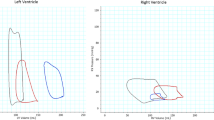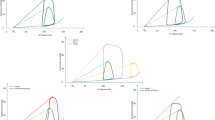Abstract
The aim was to translationally compare a pharmacologic strategy versus treatment with the Impella RP in profound RV cardiogenic shock (CS). The pigs were allocated to either vasoactive therapy with norepinephrine (0.10 μg/kg/min) for the first 30 min, supplemented by an infusion of milrinone (0.4 μg/kg/min) for additional 150 min, or treatment with the Impella RP device for 180 min. Total RV workload (Pressure-volume-area × heart rate*103(mmHg/min)) remained unaffected upon treatment with the Impella RP and increased in the vasoactive group (CS 179[147;228] to norepinephrine 268[247;306](p = 0.002 compared to Impella RP) and norepinephrine + milrinone 366[329;422] (p = 0.002 compared to Impella RP). A trend towards higher venous cerebral oxygen saturation was observed with norepinephrine than Impella RP (Impella RP 51[47;61]% vs norepinephrine 62[57;71]%; p = 0.07), which became significantly higher with the addition of milrinone (Impella RP 45[32;63]% vs norepinephrine + milrinone 73[66;81]%; p = 0.002). The Impella RP unloaded the failing RV. In contrast, vasoactive treatment led to enhanced cerebral venous oxygen saturation.




Similar content being viewed by others
Abbreviations
- CS:
-
Cardiogenic shock
- CVP:
-
Central venous pressure
- EDV:
-
End-diastolic volume
- EDP:
-
End-diastolic pressure
- ESP:
-
End-systolic pressure
- HR:
-
Heart rate
- LV:
-
Left ventricle
- MAP:
-
Mean arterial pressure
- PAP:
-
Pulmonary artery pressure
- PVA:
-
Pressure-volume area
- RV:
-
Right ventricle
- SW:
-
Stroke work
References
Helgestad OKL, Josiassen J, Hassager C, Jensen LO, Holmvang L, Sørensen A, Frydland M, Lassen AT, Udesen NLJ, Schmidt H, Ravn HB, Møller JE. Temporal trends in incidence and patient characteristics in cardiogenic shock following acute myocardial infarction from 2010 to 2017: a Danish cohort study. Eur J Heart Fail. 2019 Nov;21(11):1370-1378
Goldberg, R. J., Spencer, F. A., Gore, J. M., Lessard, D., & Yarzebski, J. (2009). Thirty-year trends (1975 to 2005) in the magnitude of, management of, and hospital death rates associated with cardiogenic shock in patients with acute myocardial infarction: A population-based perspective. Circulation, 119, 1211–1219.
Goldberg, R. J., Makam, R. C., Yarzebski, J., McManus, D. D., Lessard, D., & Gore, J. M. (2016). Decade-long trends (2001-2011) in the incidence and hospital death rates associated with the in-hospital development of cardiogenic shock after acute myocardial infarction. Circulation. Cardiovascular Quality and Outcomes, 9, 117–125.
Engstrom, A. E., Vis, M. M., Bouma, B. J., et al. (2010). Right ventricular dysfunction is an independent predictor for mortality in ST-elevation myocardial infarction patients presenting with cardiogenic shock on admission. European Journal of Heart Failure, 12, 276–282.
Goldstein, J. A. (2003). Right versus left ventricular shock: a tale of two ventricles. Journal of the American College of Cardiology, 41, 1280–1282.
Goldstein, J. A. (2002). Pathophysiology and management of right heart ischemia. Journal of the American College of Cardiology, 40, 841–853.
Josiassen, J., Helgestad, O. K. L., Udesen, N. L. J., et al. (2020). Unloading using Impella CP during profound cardiogenic shock caused by left ventricular failure in a large animal model: Impact on the right ventricle. Intensive Care Medicine Experimental, 8, 41.
Josiassen, J., Helgestad, O. K. L., Moller, J. E., et al. (2021). Cardiogenic shock due to predominantly right ventricular failure complicating acute myocardial infarction. European Heart Journal Acute Cardiovascular Care, 10, 33–39.
Haddad, F., Doyle, R., Murphy, D. J., & Hunt, S. A. (2008). Right ventricular function in cardiovascular disease, part II: pathophysiology, clinical importance, and management of right ventricular failure. Circulation, 117, 1717–1731.
Kapur, N. K., Esposito, M. L., Bader, Y., et al. (2017). Mechanical circulatory support devices for acute right ventricular failure. Circulation, 136, 314–326.
Inohara, T., Kohsaka, S., Fukuda, K., & Menon, V. (2013). The challenges in the management of right ventricular infarction. European Heart Journal Acute Cardiovascular Care, 2, 226–234.
Jacobs, A. K., Leopold, J. A., Bates, E., et al. (2003). Cardiogenic shock caused by right ventricular infarction: A report from the SHOCK registry. Journal of the American College of Cardiology, 41, 1273–1279.
Pfisterer, M. (2003). Right ventricular involvement in myocardial infarction and cardiogenic shock. Lancet, 362, 392–394.
Helgestad, O. K. L., Josiassen, J., Hassager, C., et al. (2020). Contemporary trends in use of mechanical circulatory support in patients with acute MI and cardiogenic shock. Open Heart, 7, e001214.
Mobius-Winkler, S., Fritzenwanger, M., Pfeifer, R., & Schulze, P. C. (2018). Percutaneous support of the failing left and right ventricle-recommendations for the use of mechanical device therapy. Heart Failure Reviews, 23, 831–839.
Pieri, M., & Pappalardo, F. (2018). Impella RP in the treatment of right ventricular failure: What we know and where we go. Journal of Cardiothoracic and Vascular Anesthesia, 32, 2339–2343.
Anderson, M. B., Goldstein, J., Milano, C., et al. (2015). Benefits of a novel percutaneous ventricular assist device for right heart failure: The prospective RECOVER RIGHT study of the Impella RP device. The Journal of Heart and Lung Transplantation: the official publication of the International Society for Heart Transplantation, 34, 1549–1560.
Moller-Helgestad, O. K., Ravn, H. B., & Moller, J. E. (1816). Large porcine model of profound acute ischemic cardiogenic shock. Methods in Molecular Biology, 2018, 343–352.
Baan, J., van der Velde, E. T., de Bruin, H. G., et al. (1984). Continuous measurement of left ventricular volume in animals and humans by conductance catheter. Circulation, 70, 812–823.
Smalling, R. W., Cassidy, D. B., Barrett, R., Lachterman, B., Felli, P., & Amirian, J. (1992). Improved regional myocardial blood flow, left ventricular unloading, and infarct salvage using an axial-flow, transvalvular left ventricular assist device. A comparison with intra-aortic balloon counterpulsation and reperfusion alone in a canine infarction model. Circulation, 85, 1152–1159.
Ortiz-Perez, J. T., Lee, D. C., Meyers, S. N., Davidson, C. J., Bonow, R. O., & Wu, E. (2010). Determinants of myocardial salvage during acute myocardial infarction: evaluation with a combined angiographic and CMR myocardial salvage index. JACC. Cardiovascular Imaging, 3, 491–500.
Briceno, N., Annamalai, S. K., Reyelt, L., et al. (2019). Left ventricular unloading increases the coronary collateral flow index before reperfusion and reduces infarct size in a swine model of acute myocardial infarction. Journal of the American Heart Association, 8, e013586.
Saku, K., Kakino, T., Arimura, T., et al. (2018). Left ventricular mechanical unloading by total support of impella in myocardial infarction reduces infarct size, preserves left ventricular function, and prevents subsequent heart failure in dogs. Circulation. Heart Failure, 11, e004397.
Overgaard, C. B., & Dzavik, V. (2008). Inotropes and vasopressors: Review of physiology and clinical use in cardiovascular disease. Circulation, 118, 1047–1056.
Apitz, C., Honjo, O., Friedberg, M. K., et al. (2012). Beneficial effects of vasopressors on right ventricular function in experimental acute right ventricular failure in a rabbit model. The Thoracic and Cardiovascular Surgeon, 60, 17–23.
Kerbaul, F., Rondelet, B., Motte, S., et al. (2004). Effects of norepinephrine and dobutamine on pressure load-induced right ventricular failure. Critical Care Medicine, 32, 1035–1040.
Hyldebrandt, J. A., Siven, E., Agger, P., et al. (2015). Effects of milrinone and epinephrine or dopamine on biventricular function and hemodynamics in an animal model with right ventricular failure after pulmonary artery banding. American Journal of Physiology. Heart and Circulatory Physiology, 309, H206–H212.
Annane, D., Ouanes-Besbes, L., de Backer, D., et al. (2018). A global perspective on vasoactive agents in shock. Intensive Care Medicine, 44, 833–846.
Lincoln, J. (1995). Innervation of cerebral arteries by nerves containing 5-hydroxytryptamine and noradrenaline. Pharmacology & Therapeutics, 68, 473–501.
Cavallotti, C., Bruzzone, P., & Mancone, M. (2002). Catecholaminergic nerve fibers and beta-adrenergic receptors in the human heart and coronary vessels. Heart and Vessels, 17, 30–35.
Bola, R. A., & Kiyatkin, E. A. (2018). Inflow of oxygen and glucose in brain tissue induced by intravenous norepinephrine: relationships with central metabolic and peripheral vascular responses. Journal of Neurophysiology, 119, 499–508.
Prielipp, R. C., MacGregor, D. A., Butterworth, J. F., et al. (1996). Pharmacodynamics and pharmacokinetics of milrinone administration to increase oxygen delivery in critically ill patients. Chest, 109, 1291–1301.
Karasawa, F., Okuda, T., Tsutsui, M., et al. (2003). Dopamine stabilizes milrinone-induced changes in heart rate and arterial pressure during anaesthesia with isoflurane. European Journal of Anaesthesiology, 20, 120–123.
van Diepen, S., Katz, J. N., Albert, N. M., et al. (2017). Contemporary Management of Cardiogenic Shock: A Scientific Statement From the American Heart Association. Circulation, 136, e232–e268.
Jakob Josiassen, Ole Kristian Lerche Helgestad, Jacob Eifer Møller, Jesper Kjaergaard, Henrik Frederiksen Hoejgaard, Henrik Schmidt, Lisette Okkels Jensen, Lene Holmvang, Hanne Berg Ravn, Christian Hassager, Corstiaan den Uil, (2020) Hemodynamic and metabolic recovery in acute myocardial infarction-related cardiogenic shock is more rapid among patients presenting with out-of-hospital cardiac arrest. PLOS ONE 15 (12):e0244294
Acknowledgements
We would like to acknowledge the skilled and helpful staff at Biomedical Laboratory at Odense University Hospital, Odense, Denmark.
Funding
This work was supported by the Danish Heart Foundation, Abiomed, and the Jørgen Møller Foundation. The funders had no influence on any aspects of current work.
Author information
Authors and Affiliations
Corresponding author
Ethics declarations
Conflict of Interest
Professor Møller has received a research grant from Abiomed. The remaining authors declare no competing interests.
Additional information
Associate Editor Angela Taylor oversaw the review of this article
Publisher’s Note
Springer Nature remains neutral with regard to jurisdictional claims in published maps and institutional affiliations.
Supplementary Information
ESM 1
(DOCX 313 kb).
Rights and permissions
About this article
Cite this article
Josiassen, J., Helgestad, O.K.L., Udesen, N.L.J. et al. Impella RP Versus Pharmacologic Vasoactive Treatment in Profound Cardiogenic Shock due to Right Ventricular Failure. J. of Cardiovasc. Trans. Res. 14, 1021–1029 (2021). https://doi.org/10.1007/s12265-021-10131-x
Received:
Accepted:
Published:
Issue Date:
DOI: https://doi.org/10.1007/s12265-021-10131-x




